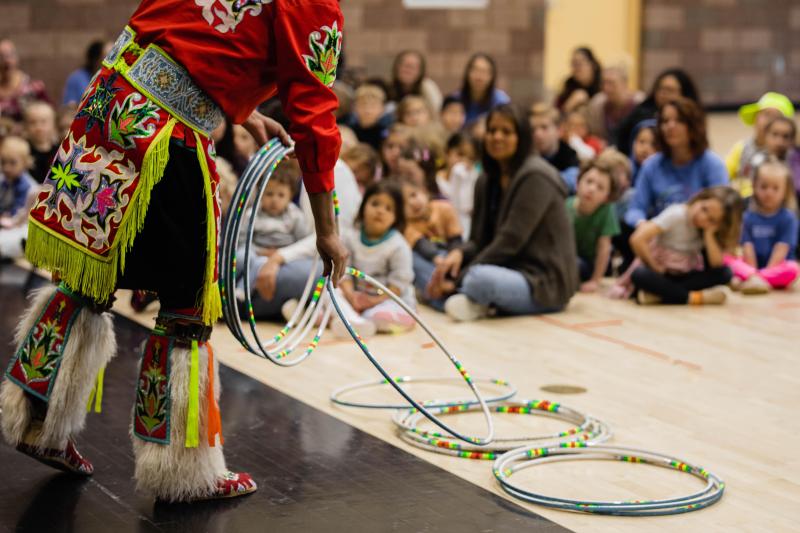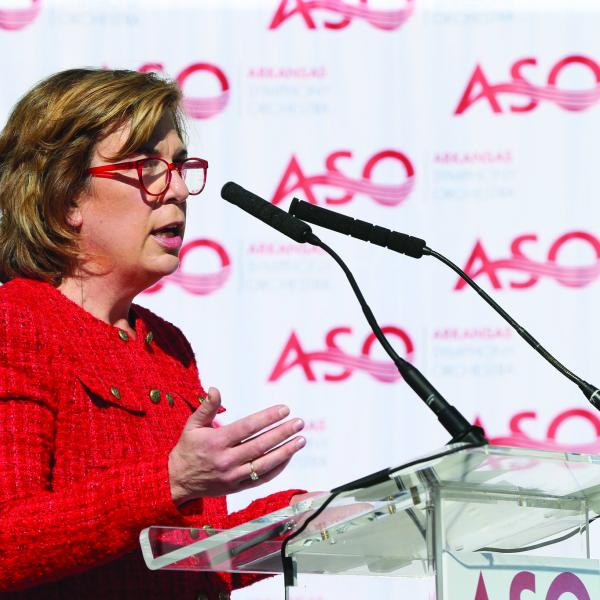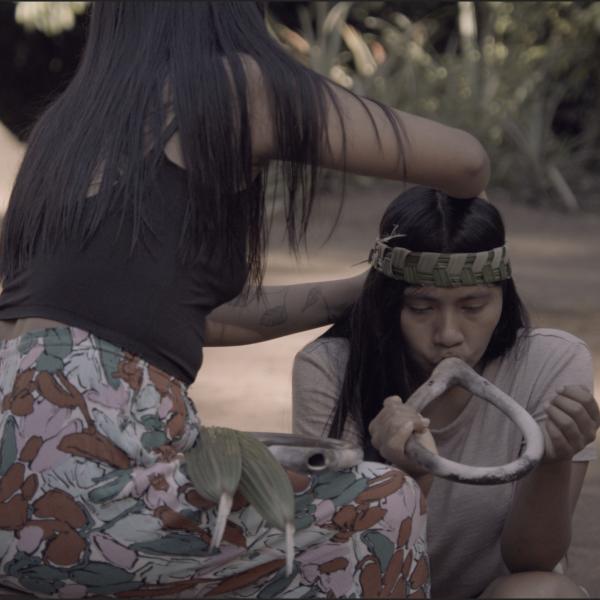Back to School Grant Spotlight: BYU ARTS Partnership Native American Curriculum Initiative

Native hoop dancer performing at an elementary school. Photo by Samuel Jake
When staff of the BYU ARTS Partnership staff wanted to reconsider how the arts could help students learn about Native cultures, they went straight to the source. They engaged Patty Timbimboo-Madsen, cultural specialist for the Northwestern Tribe of the Shoshone Nation, around the question, “What would you like children in Utah to know about your tribe?” This question sparked the development of the Native American Curriculum Initiative (NACI), a strategy to create curriculum around Native arts and culture by privileging the knowledge and leadership of Native voices.
In 2021, the BYU ARTS Partnership, an initiative of Brigham Young University's David O. McKay School of Education, received funding from the National Endowment for the Arts (NEA) to support NACI, which is a collaboration among the BYU ARTS Partnership, the Utah Division of Arts and Museums, and representatives of the Tribal Sovereign Nations within Utah’s boundaries—created to teach children about Native history and culture through the arts.
We videochatted with Cally Flox, director of the BYU ARTS Partnership and Brenda Beyal (Diné [Navajo]), a program facilitator of the BYU ARTS Partnership, about the mission of NACI, the importance of privileging Native voices when telling the stories of Native people, and how NACI has benefitted Utah youth.
NEA: Can you talk about the origin story of the BYU ARTS Partnership Native American Curriculum Initiative (NACI) and the need in the community that sparked this initiative?
CALLY FLOX: The BYU ARTS Partnership was founded in 2005, with the goal to increase the quality and quantity of the arts in public education. The need for better conversations around cultural appropriation was becoming very apparent. [When Brenda] first started working with us, her first assignment was to vet everything on our website.
BRENDA BEYAL: I’m a retired school teacher, and I was hired [to work with BYU ARTS Partnership] to help oversee the writing of arts-integrated lesson plans. I went home and I took a look at the lesson plans on the website and there was a video in one of the Native dance lessons that was problematic because reinforced stereotypes and homogenized Native cultures. I told my husband, “This is the shortest job I'll ever have,” because I knew I would have to go back and tell Cally, “This is inappropriate and I don’t know if I can do this.” But as soon as I went to Cally, she said “Well, what do we need to do? How do we fix this?” That initial listening and then taking action, which is really part of allyship, made such a difference to me. We decided that it was time to replace some of the lessons and begin writing lesson plans that shared Native American content in a culturally accurate and authentic manner.
It was important for us that right from the beginning we engage Native communities, peoples, artists, elders, and official voices into this conversation and partner with them in creating materials that would be used in classrooms. We also felt that it was important that a Native American person be brought into the classroom [to interact with the students] because that also touches on one of our guiding principles, which is bringing Native Americans into the present. So often we feel like Native Americans are part of the past, that when we think about a Native American, we automatically think about feathers or a buckskin dress. We don't think about the engineer or the teacher that's Native American.
NEA: In your own words, what is the mission of NACI?
BEYAL: The mission is to amplify Native voices and to help children experience arts-integrated lessons or resources that have Native American content. A personal mission of mine is that children of color, specifically Indigenous children, see themselves reflected in the curriculum.
NEA: Can you walk us through a lesson from the NACI curriculum?
BEYAL: One lesson that comes to mind is a weaving lesson created with the Division of Diné Education. The art form that we use as our vehicle is visual arts, but we also integrated [this concept] into language arts, math, and social studies. We use this metaphor where, if you have a loom, you have the warp, which are the threads that go up and down and are the permanent parts of the loom or the weaving. They are what the weft is woven through.
We asked the Division of Diné Education what they felt the important values were that have continued to help the Navajo Nation grow and the values that are within their culture. We teach the children that those values are the warps, continuing values, and sense of responsibility that the Navajo people have. And through the experiences that they have been able to weave through, they became resilient and continue to move forward today. One of the weft threads is the Long Walk that they were taken on in 1864, where they were taken away from their homelands, and that is an experience that if not woven through a set of values and principles, may have been permanently devastating.
NEA: What short- and long-term impacts do you hope to see on both students and educators as they engage with Native arts lessons and interact with Native artists?
FLOX: Experiential learning is essential in education and that’s one reason the arts have such value. The depth and richness of focusing on a specific culture … may transfer into other cultures’ respect for other people, and the children will be changed from the inside out. When we bring in contemporary Native American artists, it is transformative for children and adults. The artists tell their stories about what their life was like growing up in our state. Those are the stories that really make people aware of how they're treating Native people today.
BEYAL: The arts can tell hard stories and they can tell them in a way that is inclusive. It is important for students to understand that amplifying someone's Native voice does not supplant someone else's voice. Amplifying the Native voice allows for contributions to be honored and stories to be told that have been caged up for many decades.
NEA: One element of the initiative is helping classroom teachers choose culturally accurate and authentic literature. If you had to give a teacher three books and a piece of advice to start off their toolkit of Native literature, what would that be?
BEYAL: The books that I would choose include are as follows. Fry Bread: A Native American Family Story by Kevin Noble Maillard. Fry bread is something that has beginnings during a really hard time for Native Americans, but because of resilience and creativity, it has now become a bread that is eaten across the United States by Indigenous communities. Beauty Beside Me: Stories of My Grandmother's Skirts by Seraphine G. Yazzie is a wonderful telling of traditional ways and intergenerational relationships, which are important in Indigenous communities. Ancestor Approved: Intertribal Stories for Kids by Cynthia Leitich Smith is a story about several characters going to a Michigan powwow. These Indigenous characters are coming from all over the United States and they're coming with their personal stories, which are a reflection of their own distinct culture.
If I were to give a recommendation to teachers, I would tell them to go on our website and take a look at the information regarding how to evaluate books for cultural responsiveness and appropriateness. Then look for the positionality of the author and how they are connected to the tribal nation they are writing about.
NEA: There are several partners collaborating on this initiative, including representatives from the Tribal Sovereign Nations of Utah and the Utah Division of Arts and Museums. Can you tell me more about other community partners and what roles they play?
BEYAL: We partnered with the Utah Education Network, an organization where 90 percent of teachers in Utah go to for information, to help revamp their American Indian resources page and update all of their resources to make sure that teachers are getting suggestions of websites that are approved [for Native lesson planning]. In June, we partnered with the Utah Division of Indian affairs and they gave us a spot to present during the Governor’s Native American Summit. They also have quarterly tribal meetings with all of the tribal leaders in the state, and they give us opportunities to share what we are doing in our initiative.
One of the things about partnerships is that we really believe in reciprocity, which is part of our guiding principles. Due to COVID restrictions, the Northwestern Band of the Shosone Nation wasn’t able to invite all tribal members to the annual commemoration of the Bear River Massacre on site at the borders between Idaho and Utah. They came to us and said, “Do you know of anybody that we could ask to film this?” So, we filmed and edited the commemoration, and they were able to put it on their website for tribal members who could not attend.
NEA: How has funding from the NEA helped support the work of NACI?
BEYAL: One of the things funding has helped with is bringing [Native] artists in, amplifying their voices, and helping Native artists be paid like [other] artists and respected for their cultural arts.
FLOX: Funding increased our confidence and improved our ability to partner. It synergistically brought in more resources because our partners all come with their resources. The impact can't be measured in dollars—the impact is measured in the result of those dollars and what it attracts. And it was a huge magnifier. To the NEA, thank you for that.
NEA: Finish this sentence: Native voices matter because…
FLOX: They represent individuals with a deep rich history and thoughtful way of being that can benefit all of us. Native voices bring a piece into our history that is unique and often misunderstood. We can access parts of ourselves and learn to be deeply connected to where we are born and where we are serving in a respectful, sustainable, and authentic way.
BEYAL: I am a Diné woman. I grew up on the reservation. I have experienced living by a border town. I have a lived experience as an Indigenous person. Native voices matter because our history with America has been volatile, very sad, and diminished. I feel it is extremely important that our voices be heard so that we can release deep-seated trauma. Until we’re able to acknowledge that [tribal] sovereignty was here before Christopher Columbus and that there were people, trade ways, and arts and culture already here—we're not going to heal as a country.





